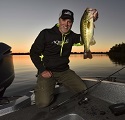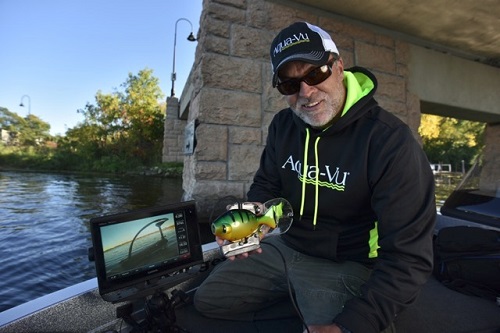 Given the drastic reduction in size, huge increase in performance, and ease on the pocketbook, I’m convinced the underwater camera is here to stay. Used in combination with mapping and sonar, there is no better combination of tools available to help anglers decipher lake structure and fish behavior secrets. I know I’m using my Aqua-Vu in more situations all the time.
Given the drastic reduction in size, huge increase in performance, and ease on the pocketbook, I’m convinced the underwater camera is here to stay. Used in combination with mapping and sonar, there is no better combination of tools available to help anglers decipher lake structure and fish behavior secrets. I know I’m using my Aqua-Vu in more situations all the time.
Case in point, this past year we were filming a Lake Commandos episode on a lake known for its largemouth, but there was a small population of big smallmouth there as well. About 100-150 yards down a long weedline, my guest caught a 4-pound smallmouth. We turned back around and she caught another in roughly the same spot. After this happened a third time in this one little stretch of weedline, I got curious to find out what was holding the fish. So I dropped the Aqua-Vu over and discovered a 15-yard field of boulders that started inside the weedline and spread out deeper. And there were 3-pound and bigger smallies spread out over the rock!
This situation is just one of many and illustrates how important understanding “spot on the spot” locations can be to consistently catching fish. First, consider that there was almost no indication of the rocks on the the graph due to the weed cover.
Yet, with the camera, not only did we learn there were rocks down there, we figured out where the bigger boulders were and how the fish were positioned. So, when we came down the weedline again, it was a lot easier to fish effectively.
And that’s just one example of how Aqua-Vu cameras have helped me better understand lake structure, cover and fish behavior.

Historically, putting underwater cameras into practice has been far from convenient. When the technology first hit the scene weight and size was an issue; it was like dragging around a dormitory refrigerator! And even as cameras grew smaller, screens were often hard to read in the sun. Lastly, there was always a lot of labor to put it all together, get it to run right and interpret what was on the small screen.
Aqua-Vu has made huge advancements in all of these areas. New models like the AV Micro 5 offer an unprecedented level of portability (fitting into your pocket), brighter screens, cool features live a built-in DVR, and ease of use. For me, I love the fact that new cameras are also compatible with the sonar units on my boat. So, rather than having to carry a camera, screen and other hardware, I’m simply attaching the Aqua-Vu Multi-Vu Complete Camera System to my Garmin 7612XVS. It’s as easy as connecting one wire, hitting a couple buttons and dropping the camera overboard. Some sonar units may require the addition of an RCA to BNC connector to integrate the camera, but these are available at RadioShack for under $10.
Nothing beats viewing underwater footage on the big screen of a video-capable sonar combo unit. On my Garmin, I can view underwater video in full-screen brilliance or run split-screen to compare with 2D sonar, cartography or Down- and Side-viewing technologies. That can be really revealing! And with the HD resolution found in units like the Garmin 7612XVS, the images are just stunning!
I’ve found that the Aqua-Vu penetrates 20’-25’ in clear waters to reveal structure, cover, transition areas – and the fish species of the marks on my 2D sonar, saving countless hours of fishing time. Are the fish I’m seeing on my graph really smallmouths? Or am I targeting suckers? (I’ve run into this twice in the past year!) Used as a species verification tool, the Aqua-Vu is a huge confidence-booster. You look down and say, “Wow, there’s a bunch of walleyes” or “Wow, look at the size of that bass!” I’m still like a kid in a candy store.
Recommendations
I’ve found that one of the best ways to learn waters is to allow some undivided time to camera use/underwater study. Choose a day when the conditions are tough, like when the lake’s flat calm, and go out with your GPS/sonar and get to know key structure in a way nobody else does. Leave the fishing rods in the locker, lower the camera into the water, and idle around off-shore reefs, points, cribs, what-have-you. Study what you see and when you find boulders interspersed along a weedline or bottom transitions you didn’t know were there, drop a waypoint. Then you’ll have something nobody else on the lake does!
About Steve Pennaz
Steve Pennaz excels at finding and catching fish on new waters, a skill developed over 30 years of extensive travel in search of giant fish. His television series, Lake Commandos, Man vs. Lake vs. Man, helps anglers understand the steps to building successful patterns on the water.
